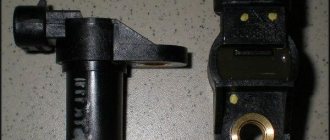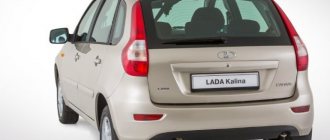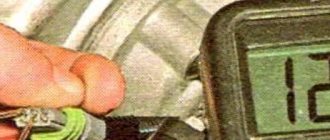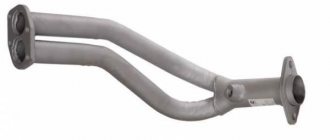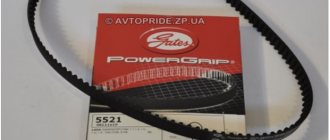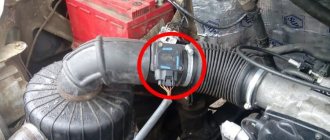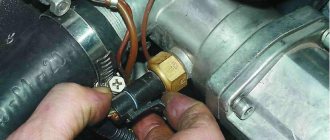The main role of the speed sensor (DS) is to obtain information about the number of revolutions transmitted from the gearbox gears to the front wheels of the car, as well as transmitting this data to the electronic control unit (ECU).
The controller processes the received information and transmits it to the control panel, thereby informing the driver about the speed of movement and the distance traveled.
In addition, based on the same information, the ECU calculates the required proportions for the fuel mixture supplied to the engine cylinders.
There may be two types of speed sensors in VAZ 2114 cars:
- a sensor with a mechanical drive from the gearbox gear and a cable drive of the speedometer (has a side outlet for wires and a seat for the cable);
- sensor with mechanical drive from the gearbox and electronic connection to the controller;
The speed sensor is located on the rear of the engine on top of the gearbox housing.
Features of replacing the speed sensor on VAZ-2113, 2114, 2115
The main role of the speed sensor (DS) is to obtain information about the number of revolutions transmitted from the gearbox gears to the front wheels of the car, as well as transmitting this data to the electronic control unit (ECU).
The controller processes the received information and transmits it to the control panel, thereby informing the driver about the speed of movement and the distance traveled. In addition, based on the same information, the ECU calculates the required proportions for the fuel mixture supplied to the engine cylinders.
There may be two types of speed sensors in VAZ 2114 cars:
- a sensor with a mechanical drive from the gearbox gear and a cable drive of the speedometer (has a side outlet for wires and a seat for the cable);
- sensor with mechanical drive from the gearbox and electronic connection to the controller;
The speed sensor is located on the rear of the engine on top of the gearbox housing.
Malfunctions
Signs of a broken DS are:
- incorrect speedometer readings (chaotic needle movement);
- problems with the engine idling;
- error message (code 0500, 0501);
- “floating” speed;
- “failures” during acceleration;
- increased fuel consumption.
DS malfunctions include:
- lack of contact in the connector;
- sensor wiring break;
- breakdown of the mechanical drive of the sensor;
- failure of the sensitive element (for electronic DS).
After checking the contacts and wiring and making sure that everything is in order, you need to remove the sensor from its seat and replace it with a new one. If the sensor is not replaced, the ECU will “force” the engine to operate in emergency mode, which will lead to increased fuel consumption, as well as wear and tear on other elements of the fuel system.
The speed sensor itself is inexpensive: mechanical versions cost 300-500 rubles. Replacing it at a service station will cost approximately 200-300 rubles.
However, it is not necessary to overpay for the work. The speed sensor can be easily replaced independently in 15-20 minutes.
When purchasing a DS, you need to pay attention to its manufacturer and the material used to make the rod. A rod made of plastic may fail after just a few days. By the way, if the rod falls apart, you will have to disassemble the gearbox.
Functions
It is incorrect to assume that the DS serves solely to transmit information regarding the current speed of the vehicle. In fact, this device has several tasks.
- Transferring information to the dashboard, namely the speedometer, about the speed of the car.
- Supports optimal functioning of the idle air control.
- Transferring data to the electronic control unit in order to maintain optimal speed depending on the travel mode.
The DS is connected to the speedometer and controller using a mounting block located in the engine compartment. And inside the car, directly on the heater fan relay, there is a sensor fuse.
Errors and symptoms
If the device starts to work incorrectly or breaks down, you should pay attention to the on-board computer screen. Diagnostics of errors will determine that the DS has stopped functioning properly and measures should be taken to eliminate the breakdown
| Error code | What does it mean |
| P0500 | This error indicates that the computer does not receive a signal from the speed sensor. |
| P0503 | This error code informs about the receipt of an unstable signal from the DS, which is intermittent. |
If these error codes appear on the dashboard, you should definitely inspect the electrical circuit for oxidation or damage to the integrity of the contacts. Often it is because of this that the DS stops transmitting information.
But there are other signs by which you can determine that the DS is out of order:
- On the dashboard, the speedometer shows incorrect speed data or the needle does not move at all;
- With a slight acceleration, the speed floats, the engine switches off on its own;
- Fuel consumption increases;
- Engine power is noticeably reduced.
These signs may be signals of problems with other systems. But if you find one of the characteristic signs of a DS failure, plus one of two error codes appears on the on-board computer, then the problem lies precisely in the speed sensor.
Functionality check
Do not rush to replace the device until you are sure that the faulty sensor is the culprit of the problem.
The check is performed in several ways. Decide for yourself which one you prefer.
Before doing this, be sure to check the condition of the wiring and contacts. If they are oxidized or rusted, or there are breaks in the circuit, then the DS itself may well be operational. You just need to return the wiring and contacts to a functional state. If the check shows that everything is intact and there are no problems with the contacts, then diagnose the speed sensor.
- If you don’t want to remove the DS, then place the car on a level surface, secure it with blocks and lift the left front wheel with a jack. Connect the voltmeter to the contacts of the sensor and begin to rotate the wheel with your hands. At the same time, look at the voltmeter data. If the voltage increases with frequency in proportion to the increase in wheel speed, the DS operates normally.
- Another method also does not require removing the measuring device. But for this you will need a test lamp. Use a jack to lift the left front wheel and connect the test lamp to the DC contacts. After this, manually rotate the wheel. If the lamp lights up, the sensor is working well.
- The third method involves dismantling the sensor and then checking the input and output voltage. The device for measuring the indicators will be a voltmeter.
- The fourth method is actively used by those who prefer to repair their car with their own hands. Here you have to check the sensor drive. To do this, lift the wheel using a jack and remove the sensor. Feel for the DS drive, and then begin to rotate the wheel. You can feel with your fingers that the drive rotates. If there are no jams, everything rotates evenly, then the drive is in good condition.
If a malfunction of the DS is detected, the only correct solution is to remove it and replace it with a new sensor.
Having determined that your DS has already served its purpose, you can begin the replacement procedure.
Self-replacement of the sensor
- Raise the hood and turn off the power by removing the ground terminal from the battery.
- For ease of operation, remove the air duct corrugation.
- When access to the sensor is open, disconnect the wires from it.
- Turn the sensor body counterclockwise by hand and unscrew it.
- If you suspect a malfunction of the drive, unscrew the nut securing it with a 10mm wrench and pry off the drive housing with a slotted screwdriver.
- Carefully remove the drive.
- Install the new drive and secure it.
- Install the new sensor and connect the wires.
Vehicle speed sensor VAZ 2115
Some car sensors and sensors only manifest themselves in the event of a breakdown. For example, the operation of the VAZ 2115 speed sensor is invisible during operation. Many drivers do not know that in addition to speedometer readings and mileage tracking, this device performs several more functions:
- Idle speed is adjusted even when the car is moving, based on speed readings;
- control of air supply bypassing the throttle assembly;
- When the throttle valve is closed, the engine control unit receives signals from the speed and crankshaft speed sensors.
Frequent causes of speedometer drive failure
- Long service life - each device has its own service life.
- Something fell on the sensor and damaged its connection.
- The wires have dried out or the contact has simply come loose, which prevents the device from working.
- Complex design features of use, increased amount of humidity and constant contamination of the space under the hood.
- Installing a device of poor quality or purchasing a cheap speed sensor without special qualities and characteristics.
Design and principle of operation
The sensor is a complex of mechanical and electronic components operating according to the Hall principle.
The rotating parts convert the electrical signal into a chain of pulses that are multiples of the rotation of the sensor axis. Due to the mechanical connection of the sensor rod with the wheel hub, the rotational movement of the wheel is converted into the distance traveled.
- when the outer surface of the tire rotates 360°, the wheel moves horizontally a certain distance;
- this path is equal to the circumference of the tire, it is programmed into the engine ECU;
Important: Installing wheels of a non-standard size disrupts the operation algorithm of the VAZ 2115 speed sensor.
Both of these parameters are involved in the coordinated operation of the engine's electronic control unit.
Operating principle
Thanks to the device of the measuring device, which was discussed in the previous paragraph, it seems possible to carry out the following action to measure the speed of a vehicle on the road:
- As soon as the tire on the disk rotates three hundred and sixty degrees relative to its original axis, the mechanical rim of the device slightly changes its position, which immediately becomes known to the driver in the form of “kilometers per hour.”
- This path is preset by the car’s designers in the engine ECU; most often it is equal to two tire radii. That is, its full length.
- Do not forget that to determine speed, the distance traveled is divided by the time spent in motion.
What happens if this sensor breaks?
Of course, the car will not stall, and you can continue driving it, but only to the place of repair.
- Absence or incorrect readings of the actual vehicle speed. The speedometer needle “hangs” at one mark, moves chaotically, or does not deviate from “zero” at all.
- On a moving vehicle, when the accelerator is released, interruptions in idle operation are observed.
- Floating idle speed when stopping.
- Unreasonably high fuel consumption.
- During intense acceleration, dips in traction occur: there is no increase in power in proportion to pressing the gas.
Where is the speed sensor located and why does it break?
The sensor is located on the gearbox housing, in its upper part. To get to it, you need to lift the car on a lift, or use the inspection hole.
The device and its electrical wiring are affected by moisture, road reagents and temperature changes. The causes of the malfunction are the following:
- breakage of connecting wires;
- corrosion of the connector terminal block;
- mechanical failure of the rotating rod;
- failure of the electrical part.
The symptoms of any of the breakdowns are the same; the sensor itself cannot be repaired: only replaced. Only oxidized contacts or broken wiring can be restored.
How to check
First of all, we carry out a visual inspection. The wires must be intact and have no obvious kinks or damage to the insulation. The cleanliness of the contacts on the connector is also checked. After inspection, we check the electrical part of the device.
- You can jack up one of the front wheels of the car and spin it with the ignition on (we don’t start the engine). Voltage surges are checked using a multimeter at the information contact (central terminal).
- If you remove the sensor, you need a device to force the rod to rotate. A voltage of 12 volts is supplied to the power terminals, the tester is connected to the negative terminal and the signal contact. When rotating, we register impulses. If they are not there, the sensor needs to be changed.
To replace, you will need a 21 key. We replace the faulty part with the negative terminal of the battery reset.
Advice: You should not save money by buying a cheap sensor from a dubious manufacturer. A branded part is not so expensive that you risk a breakdown on the road, where there will be no way to diagnose and replace the speed sensor.
Examination
In order to check the device for any damage, defects or malfunctions, it is necessary to conduct a visual inspection using specialized equipment.
In appearance, the VAZ 2115 speed sensor should not have any visible damage; the body and wires must be intact and not covered with corrosion or rust. The device should not emit an unpleasant oily smell, no liquid should drip from it, and it itself should be held tightly in the mounting socket.
Self-replacement of the VAZ 2115 speed sensor
You discovered that your VAZ 2115 car began to stall at idle, “floating” speedometer readings appeared, engine thrust dropped, and fuel consumption increased - all this means that the speed sensor is acting up. Replacing the speed sensor of a VAZ 2115 is not difficult. It is enough to know where it is located and how to get to it. The procedure will take very little time and will save you money, and our instructions will help you. Let's start in order.
Purpose
The purpose of the VAZ 2115 speed sensor is to measure the speed of the vehicle on the roadway. The driver needs this information to competently assess the situation on the road and make appropriate decisions. In places with maximum speed limits, the driver needs a speed sensor to avoid violations and fines.
In addition, a speed sensor is necessary for more precise control of the vehicle. Before turning, when driving downhill, overtaking passing vehicles in front and other specific situations, the driver should first pay attention to the speed of his vehicle at the moment. Otherwise, if you make a mistake while driving against the backdrop of an incorrectly displayed current vehicle speed, there is a risk of a serious accident with not the most pleasant consequences.
Principle of operation
The operating principle of a modern speed sensor (hereinafter DS) is based on the Hall effect:
- The speed sensor transmits voltage pulses to the controller with a frequency directly proportional to the speed of the drive wheels.
- The controller, based on sensor pulses, regulates engine operation in idle mode, and with the help of the IAC (idle speed controller) controls the supply of air bypassing the throttle valve.
- In this case, the frequency of the DS signals is directly proportional to the actual speed of the car.
- DS differ in the connecting connectors to the harness block.
- BOSCH systems use a square connector.
- The sensor, which has a round connector, is used in systems such as GM and January 4.
- All of these sensors are six-pulse; they produce six pulses per axis rotation.
- A ten-pulse sensor is found in Samar carburetor trip computers.
Signals from the speed sensor are used by the control system to calculate fuel shut-off thresholds, and to electronically force limit the speed of the machine (in modern control systems). When installing the speedometer drive in models that still have one in the box, you need to be very careful, otherwise, when misaligned, the fragile plastic teeth on the speedometer drive drive gear will be crushed and then you will have to completely disassemble the entire gearbox (to replace the broken drive) and the cost of the issue increases . The output voltage for a low pulse level is permissible no more than 1 V, and for a high level it must be at least 5 V.
Types of installed meters
Replacing a speed sensor with your own hands for a VAZ 2115 is not much different from replacing it on any car of the “tenth series” (for example VAZ 2110-2112), as well as the Samara series (VAZ 2113-2115), and new products such as Lada Kalina , Grant or Priora. The sensor itself is located on the rear side on top of the gearbox (when viewed from the radiator) directly above the differential, where the wires come out (in the photo below it is shown by an arrow, look under the pipes).
The meter we are looking for is located under the pipe indicated by the arrow.
At different times, three types of sensors (meters) were installed on VAZ models. The first of them is no longer used on new cars.
Type No. 1
Installed on the first Samaras with an injector with a cable-driven speedometer:
- It was installed as an “intermediate insert” between the speedometer cable and the gear output to the gearbox.
- Wires with a connector extend from it to the side.
Speed meter of the first (oldest) type
- Its malfunction can only be determined with a special diagnostic tool at the same speed at idle. And also when the car is coasting and when stopping.
Sometimes, when such a breakdown occurs, the car begins to stall immediately after engaging the “neutral” (neutral gear) while driving. This happens due to the fact that the car, when driving, maintains a slightly higher idle speed initially (1000 instead of 850 if the car is stopped). This is designed for smooth shifting when coasting from neutral to gear.
Attention: Before replacing, it is recommended to check the drive mechanism (on which the meter sensor is screwed)
You can do this by trying to turn the drive using any available means. Carefully! So as not to break the square window.
Type No. 2
A newer model of the meter is installed on subsequent models of injection vases. Its main difference is an electronic speedometer and the complete absence of a cable. It is screwed directly onto the output of the drive gear.
Type 2 speed meter, newer model without cable
If it breaks down, the speed of the car stops being displayed on the instrument panel. The rest of the symptoms are the same as those of the first model.
Type No. 3
The newest version in which the unreliable drive mechanism (in the event of a breakdown, the box had to be removed and disassembled) has been replaced with a modern electronic one (which is based on the Hall effect).
Speed meter based on the Hall effect
The consequences of failure of such a meter are exactly the same as those considered in the previous analogue. However, on cars with this type of sensor, electric power steering (abbreviated as EPS) is installed. If the meter fails, the force when turning the steering wheel changes, and in some cases the EUR winding burns out. This is especially unpleasant if there is a “floating” defect in the speed meter. When turning, the force on the steering wheel begins to change. This scares some drivers. Now the EUR has been abandoned.
Attention: Such meters have completely different markings for Priora and Kalina and are not interchangeable!
Before buying a new one, you need to check which meter is installed on your machine. The marking of the meter is written on its side belt.
Tips for motorists
Nowadays, driving a VAZ-2115 passenger car with a faulty speedometer can become a very expensive task. Since the driver is unlikely to be able to accurately determine the speed of the car by eye. But on the roads, in addition to traffic police inspectors with radars, there are also camouflaged radar detectors with video recording systems, which cannot always be noticed in time. Therefore, the amount of fines can easily exceed the amount you will pay for speedometer repair.
Most VAZ-2115 cars have injection engines. In this case, they will be equipped with electronic speedometers that receive information from the speed sensor. If the VAZ-2115 is equipped with a carburetor engine, then the speedometer will be mechanically driven using a flexible cable.
The most common malfunction, due to which the readings of the electronic odometer disappear and the speedometer needle stops moving along the scale, is the failure of the speed sensor. Although, to be more precise, the same thing will happen if contact is lost as a result of corrosion in the speed sensor connector. True, the loss of contact is not always permanent; sometimes, due to vibration of the engine and transmission, contact is either lost or reappeared, and the speedometer needle begins to twitch in time with this process.
To determine a malfunction associated with a failure of the speedometer, you can do a test on the dashboard. To do this, press the daily mileage reset button, hold it pressed and turn on the ignition. If all instruments are working properly, then the arrows from the beginning of the scale move up to the end of the scale, and then return back, and this is repeated three times. The movement of the arrows will indicate that the device itself is working. This means that the reason the speedometer refuses to work when the car is moving, in this case, will be the speed sensor, which will have to be replaced.
A possible mechanical failure that could cause the speedometer to stop working could be a failure of the gear drive of the speed sensor. This happens either due to the cutting of the gear teeth, or due to the cutting of the edges of the drive shaft tip. In these cases, the torque from the secondary shaft of the gearbox will not be transmitted to the speed sensor shaft, which will lead to the absence of pulses, the frequency of which determines the vehicle speed.
Vehicle speed is the main parameter that every driver must monitor. Exceeding the permissible speed limit is not only fraught with a fine, but can also lead to serious consequences. Where is the VAZ 2115 speed sensor located, what malfunctions can occur in its operation, how to check and replace the controller - you will find answers to these questions in this article.
VAZ 2115 speed sensor replacement
Before you start replacing the speed sensor, we recommend that you inspect the connector and wires connected to it for breaks. If there is nothing wrong with them and it is just the sensor, you will need the following tools to replace it. To replace the first two types of meters:
- Slotted screwdriver (flat)
- Pliers (pliers)
- crosshead screwdriver
To replace the third last type meter:
- 10mm socket with extension and ratchet (or 10mm wrench if they are not available)
- Flat screwdriver (slotted)
- crosshead screwdriver
- Key for 22
We are starting to replace
- First, remove the inlet pipe with the filter housing from the machine.
- If there is heavy contamination around the sensor, we clean the surfaces of the box with a wire brush.
- Then we wash off the dirt using brake cleaner and wipe the surfaces and the meter with a rag.
- If we have a cable-driven speedometer, then first unscrew the cable from the meter by hand or with pliers.
- Sometimes it happens that the sensor itself gets unscrewed.
- Then you need to hold the sensor using a 22 key or by hand.
- We remove the sensor itself.
